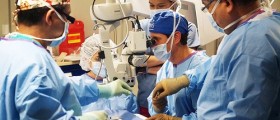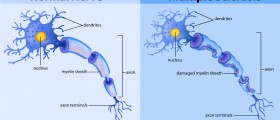
Multiple sclerosis is an inflammatory disease that affects the myelin, a protective layer surrounding the axons of the brain and spinal cord. Demyelization and scaring occurs since the body mistakenly takes myelin for a foreign object and attacks it in order to destroy it. Since the myelin becomes damaged, the communication between the brain and the body becomes broken causing different and often extremely disabling symptoms. The symptoms of the disease differ from one person to another, and they typically tend to come and go, making the accurate diagnosis often very hard. Among the most prominent symptoms of the disease is numbness and weakening of the limbs, which usually affects the lower part of the body, tremor, lack of coordination or unsteady gait. Most of the patients suffering from multiple sclerosis will become chair-bound at some point of time, and the damage done to the nerves is irreversible, in nature. However, physical therapy and especially stretching and strengthening exercises can help the patients easily perform their daily tasks. Restorative yoga can, therefore, provide the patients with some great benefits.
What is restorative yoga?
Restorative yoga is a special type of yogic exercise, which is aimed to rest the muscles and sooth the mind. The exercise typically includes a series of warm ups and some type of Sun Salutations or gentle smooth movements coordinated with the deep fluid respiration. Restorative yoga doesn’t only heal the body physically but also provides many emotional benefits, making it easier for patients to cope with different aspects of their disease. Restorative yoga uses the same poses as standard yoga, but usually slightly modified.
Yoga benefits for multiple sclerosis patients
Different physical postures, breathing exercises and meditation are very beneficial for patients with multiple sclerosis. Yoga is a great way to improve the mood, decrease the stress, relax the muscles and, to some degree, improve the patient’s strength and flexibility. Patients with multiple sclerosis can easily use blocks, blankets, cushions and chairs, to support their body and easily modify the poses and engage in a series of stretching to release pain and increase the range of motion. Many therapeutic benefits result only from breathing techniques and meditation, including improved body awareness, stress management and the inner feeling of wellbeing. Even the patients in advanced stages of multiple sclerosis may benefit from the simple exercise such as the legs-against-the-wall. The National MS Society even developed a yoga program especially designed for people with multiple sclerosis, while The American Yoga Association advises a 30-minute yoga training every day, for easing the symptoms of this disease.








-and-Multiple-Sclerosis-Differences-And-Similarities_f_280x120.jpg)








Your thoughts on this
Loading...